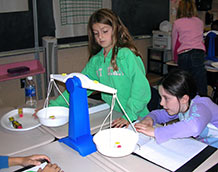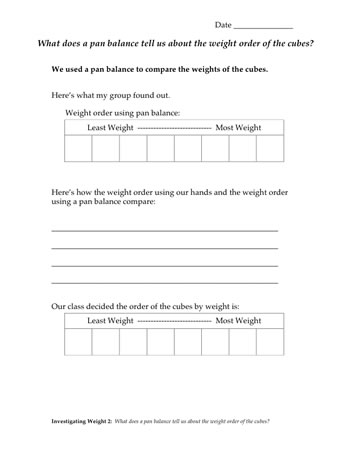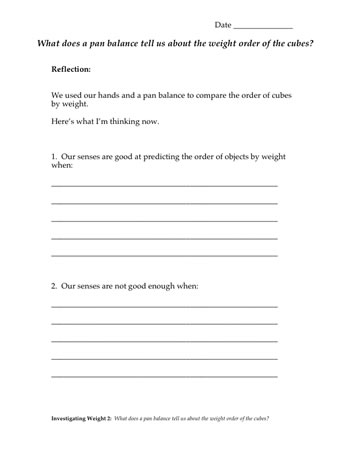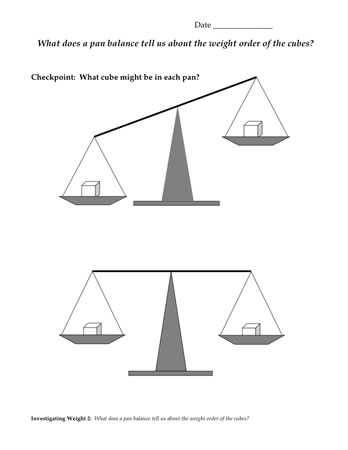What does a pan balance tell us about the weight order of the cubes?
Plan Investigating Weight 2
“Maybe this order.” … “Maybe that order.” … “This is easy.” … “No, this is hard!”
Students likely encountered difficulty and disagreement,in their quest to order the cubes by felt weight. In this investigation they get help from a scientific instrument: a pan balance.
After learning how to use the balance, students compare the weights of the cubes and arrive at an objective ordering. They then compare this new ordering to the one they got before. By the end of this investigation, students will better understand the limitations of felt weight and appreciate the value of instruments for careful measuring.
Learning Goals
- to learn how to use a pan balance to compare the weights of objects
- to recognize the limitations of felt weight
- to appreciate the value of an instrument for comparing weights
| Sequence of experiences | ||
|---|---|---|
| 1. Ask the question | All Class | 15 Mins |
| 2. Check the weight order** | Small Groups | 15 Mins |
| 3. Analyze the data | All Class | 5 Mins |
| 4. Make meaning | Discussion | 10 Mins |
| 5. Reflect | Individual | 5 Mins |
** If this is the students’ first experience with a pan balance, they may need some extra time.
Materials and Preparation
For the class:- Post the investigation question in a place where all students can see it.
- Post the investigation question from the previous investigation: How good are our senses at comparing the weights of the cubes?
- The class table from the last investigation with the “felt–weight” orderings of the cubes
- A blank table to record the pan balance ordering of cubes; an example appears in Step 2
- 1 set of cubes with the names of the materials on the cubes
- 2 pan balances adjusted for accuracy
1. Ask the question
Set up a pan balance where all students can see it.
- What do you suppose this is?
- What could it be used for?
- How do you think it might work?
Note: Students may suggest that the pan balance is used to “weigh things.” Return to that thought later, once students have seen that a pan balance can also compare the weights of objects without actually weighing them.
Check students’ understanding by having them predict what they will observe if the objects in the two pans weigh the same. Invite a student to put a steel cube in each pan. Did students predict correctly?
Next ask students to predict what they will observe if the object in this pan is heavier than the object in that pan. Invite a student to place two different cubes in the pans. Can the students explain what happens? Why do they think what they think?
Letter from the Engineer
When you were using your senses to compare the weights of cubes, sometimes that worked well, but sometimes it was very difficult — using just your hand and your senses — to decide which cube was heavier. When the weight difference between two objects is very small, our senses may not notice the difference; they are not reliable at telling us which object is heavier. That’s the kind of a problem that engineers can solve. They have designed a tool to compare the weights of objects that is more effective than our senses.
Explore students’ readiness to take the next step. Calling attention to the class table they created last session.
- How can this pan balance help us check our predicted order of the cubes?
Select three cubes and have a willing student demonstrate how the pan balance can check the orderings that they arrived at by felt weight. Check to see if students understand how to use the balance in this way.
Finally, share the new investigation question:
2. Check the weight order

Before distributing the pan balances, show students how to use the sliders to level the pans. Point out the device that indicates that the pans are level, and make sure students know how to read it. Let students know that the balances are scientific instruments and that they must handle them carefully.
Post the table from the last session alongside the new table. Have each group arrange its cubes in the weight order they decided on last time, then have them check that order using the pan balance. Ask them to record their findings both in their notebooks and in the class table.
Note: If students have not had much prior experience with a pan balance, allow time for them to explore how a balance reacts to objects in the pans and remind them to work gently. Keeping these elementary school balances well adjusted and in good working condition is important because they are not as consistent or accurate as more expensive instruments. Help students get in the habit of checking the balances prior to each use to see if any adjustments are necessary.
| Group | Least Weight → Most Weight | |||||||
|---|---|---|---|---|---|---|---|---|
| 1 | ||||||||
| 2 | ||||||||
| 3 | ||||||||
| 4 | ||||||||
| 5 | ||||||||
| Class Order | ||||||||
Students may struggle a bit if their predicted order is proven incorrect. Encourage them to go slow, comparing one pair of cubes at a time, taking careful note of which cube is heavier — perhaps also noting whether it is “much heavier” or ”a little heavier“ — then moving on to another pair.
When all the data has been recorded, ask the class to look for discrepancies in the new, measured, orderings. Have them resolve any differences using the pan balance, then record the final result in the row labeled “Class Order.” Students should also record the final order in their notebooks.
The correct order from least weight to most weight is: Pine, Oak, Nylon, Acrylic, PVC, Aluminum, Steel, Copper.
3. Analyze the data
Ask students to identify instances where information (data) from the pan balance was different from the order they found using felt weight. Mark these on the class data tables.
- When you compare the two data tables, can you find any differences in the order of the cubes by weight? Where are the differences?
Make claims based on evidence
Encourage students to identify patterns in the data — places of agreement and places of differences — and to account for the patterns with some sort of hypothesis. They will likely find that the two orderings differ most in the areas that the pan balance showed the weights to be most similar. Students might propose, correctly, that small differences in weight are difficult to distinguish by hand.
Note: The ability of our hands to sense weight differences depends not only on the relative weights of the objects but also on their actual weights. For example, our hands can tell the difference between objects weighing 20 grams and 40 grams, but probably not between objects weighing 0.2 grams and 0.4 grams, even though in both cases the weights differ by a factor of 2.
Students will find that their hands are not consistently reliable for ordering objects by weight, especially when weight differences are small. The pan balance provides more accurate and consistent results, but instruments also have their limits. Inexpensive pan balances can lose effectiveness once the difference in weight between two objects drops much below 1 gram.
4. Make meaning
Purpose of the discussion
This discussion will reveal what students are thinking about the question How good are our senses at comparing weight? and their ideas about what information a pan balance does and doesn’t provide.
Remind students that today's investigation question is:
Engage students in the focus question
How did the pan balance help you answer the question “How good are our senses at comparing weight?”
- The pan balance lets you compare the weight of two cubes.
- We had to make a few changes in the order we found using felt weight but not too many.
- The pan balance lets us check the order of the cubes by felt weight especially when the weights were close and it was hard to tell.
- The pan balance doesn't tell you how much more or less one cube weighs than another.
Supporting questions
What was the evidence that one cube was heavier than another?
- The heavier cube made the pan go down.
What do you think we would need if we want to know how much more one cube weighs than another?
- Counter weights such a plastic counting bears, paper clips, washers (that will be used in the next investigations), objects that weigh ounces or grams, etc.
Recap the discussion
Summarize the ideas you have heard. Point out that:
- The class now has more evidence to answer the question "How good are our senses at measuring weight?".
- The pan balance is a useful tool to check the relative weights of any two cubes.
- We would really like to be able to find out how much each cube weighs (this will happen in the next investigation).
5. Reflect
Provide time for students to complete the reflection in their notebooks.
A quick way to check your students' understanding of how the pan balance works as well as their familiarity with the cubes is to have them complete the "Checkpoint" sheet in their notebooks.









